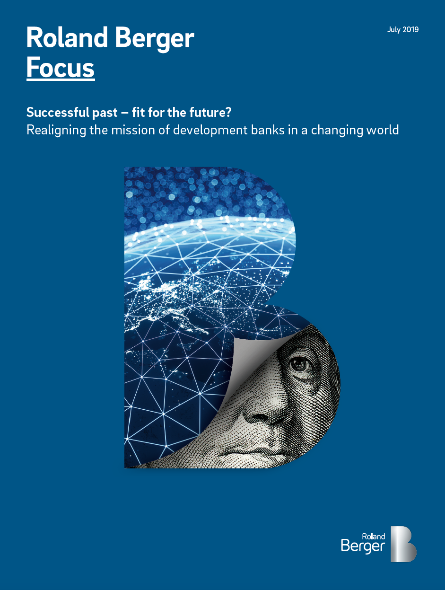How development banks can clarify and realign their missions
![{[downloads[language].preview]}](https://www.rolandberger.com/publications/publication_image/Bildschirmfoto-2019-08-13-um-10.32.50_download_preview.png)
Five general actions that can help development banks boost their impact


"Many development banks are still sticking to their original missions and legacy environments – and run the risk of inadequately countering current developments. "
Development banks play an important role to combat the absence or failure of market mechanisms, advance specific public policy goals or support wider social and economic development in their countries. Although this model has a successful track record megatrends such as digitalization, globalization, climate change and migration giving rise to new priorities and change the market environment development banks operate in. Therefore they have to adapt too. Times are changing – and so are the challenges that development banks have to face.
The study “Successful past – fit for the future? Realigning the mission of development banks in a changing world” by Roland Berger offers strategic guidance to help development banks clarifying their future roles. It discusses typical issues challenging their position, shows how an existing mission can be substantiated or realigned, and provides practical takeaways, showing how to realize such missions and enhance the banks’ impact.
First, a three-step framework provides a useful tool going forward: Identify global factors which are expected to have a significant economic, political or social impact. Analyze the future development of domestic market factors which can point development banks in the right direction for potential future priorities. And proactively align with policy priorities and divide topics among public stakeholders according to market knowledge and competence.

Armed with a clear mission development banks can move forward with greater certainty and a sharper focus. On this basis five general actions can help development banks boost their impact.
First, the status quo must be assessed. This enables strengths and weaknesses to be identified. Development banks have to ask themselves several questions: Is the current ownership structure the most efficient and effective one? Does the bank have sufficient freedom to act, or is it too heavily dependent on government stakeholders and processes within ministries and other public bodies? Are governance arrangements clearly defined and transparent to stakeholders? Are governance processes for decision-making efficient and effective?
Depending on the focus of a development bank, there are several more specific initiatives focusing mainly on creating market incentives and supporting modernization and digitalization. The diversity of development banks makes it clear that there can never be a “one-size-fits-all” approach. However, constant change must also become a constant for development banks. These banks must become more agile and take a more proactive approach than in the past to meet challenges of today and tomorrow.

![{[downloads[language].preview]}](https://www.rolandberger.com/publications/publication_image/Bildschirmfoto-2019-08-13-um-10.32.50_download_preview.png)
Five general actions that can help development banks boost their impact